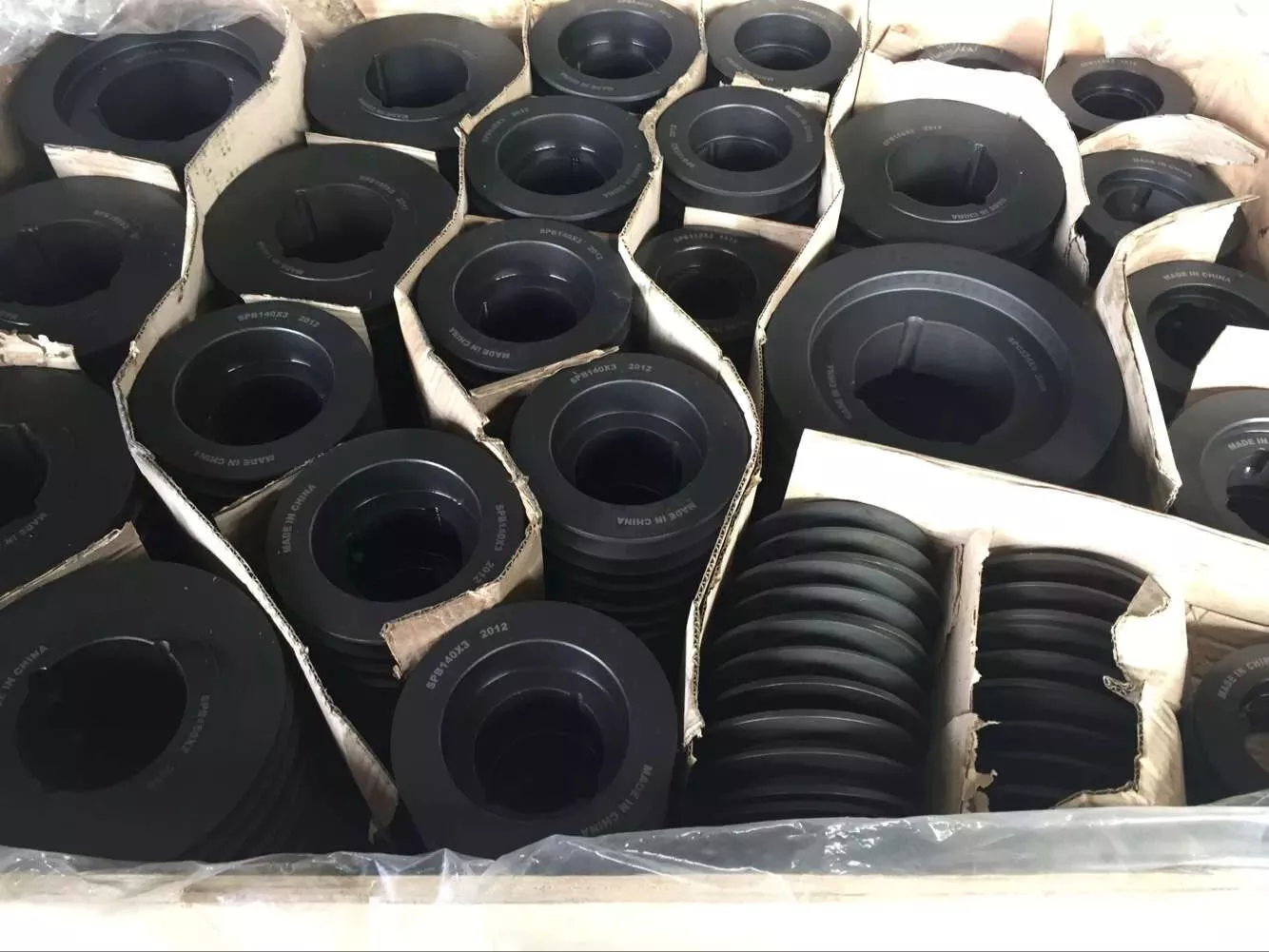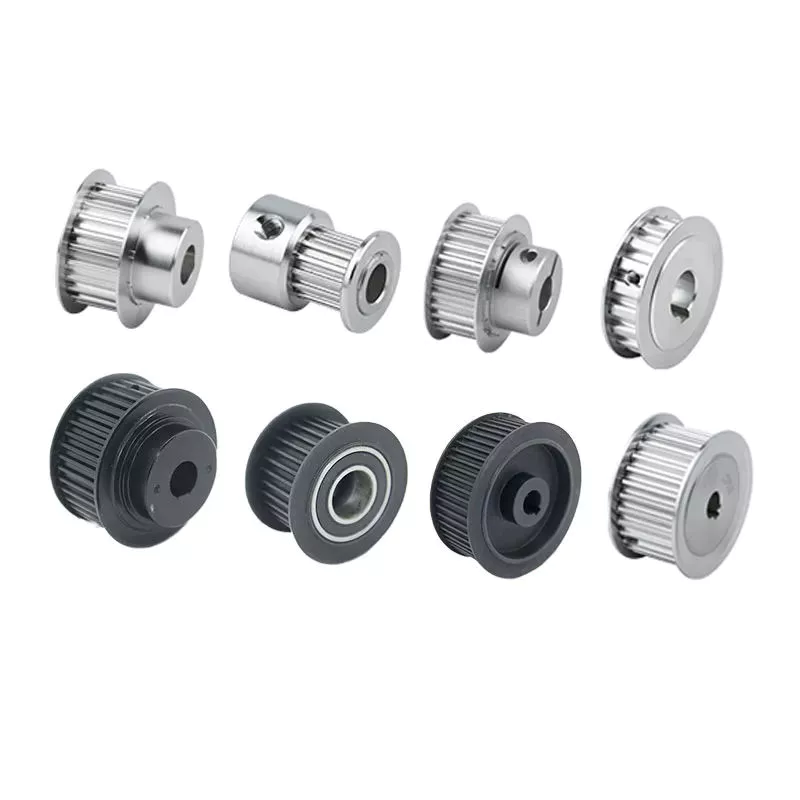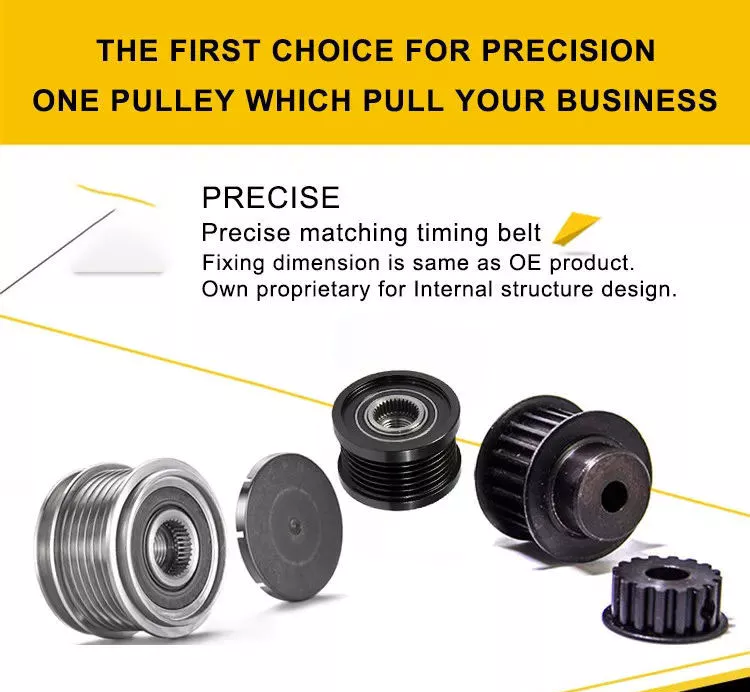Produktbeschreibung
Produktbeschreibung
Cast iron V belt pulley Cast Iron with Taper bore
With more than 15 years' experience, high-precision equipment and strict management system, CIMO can provide V belt pulley for you with stable quality and best service.
Cast Iron V Belt Pulley,V pulley, v belt pulley, v groove pulley, v groove belt pulley, taper lock pulley, taper lock v belt pulley, taper lock bushing pulley, taper lock pulleys / taper bore pulley, large v belt pulley, double v belt pulley, cast iron v belt pulley belt pulley, variable speed v belt pulleys, v belt pulley split pulley, cast iron v belt pulley
V belt pulley specifications:
1) European standard:
A) V-belt pulleys for taper bushings: SPZ, SPA, SPB, SPC; Up to 10 grooves
B) Adjustable speed V-belt pulleys and variable speed pulleys
C) Flat belt pulleys and conveyor belt pulleys
2) American standard:
A) Sheaves for taper bushings: 3V, 5V, 8V
B) Sheaves for QD bushings: 3V, 5V, 8V
C) Sheaves for split taper bushings: 3V, 5V, 8V
D) Sheaves for 3L, 4L or A, and 5L or B belts: AK, AKH, 2AK, 2AKH, BK, BKH, 2BK, 2BKH, 3BK
E) Adjustable sheaves: Poly V-pulley, multi-pitch H, L, J, K and M
3) Bore: Pilot bore, finished bore, taper bore, bore for QD bushing
4) Surface finish: Paint, phosphating, zinc plated
5) Material: Cast iron, ductile iron, nylon, aluminum
6) Made according to drawings and/or samples, OEM inquiries welcomed
| SPA56 | SPB56 | SPC56 | SPZ56 | 1008 |
| SPA63 | SPB63 | SPC63 | SPZ63 | 1108 |
| SPA67 | SPB67 | SPC67 | SPZ67 | 1210 |
| SPA71 | SPB71 | SPC71 | SPZ71 | 1215 |
| SPA75 | SPB75 | SPC75 | SPZ75 | 1310 |
| SPA80 | SPB80 | SPC80 | SPZ80 | 1610 |
| SPA85 | SPB85 | SPC85 | SPZ85 | 1615 |
| SPA90 | SPB90 | SPC90 | SPZ90 | 2012 |
| SPA95 | SPB95 | SPC95 | SPZ95 | 2017 |
| SPA100 | SPB100 | SPC100 | SPZ100 | 2517 |
| SPA106 | SPB106 | SPC106 | SPZ106 | 2525 |
| SPA112 | SPB112 | SPC112 | SPZ112 | 3571 |
| SPA118 | SPB118 | SPC118 | SPZ118 | 3030 |
| SPA125 | SPB125 | SPC125 | SPZ125 | 3525 |
| SPA132 | SPB132 | SPC132 | SPZ132 | 3535 |
| SPA140 | SPB140 | SPC140 | SPZ140 | 4030 |
| SPA150 | SPB150 | SPC150 | SPZ150 | 4040 |
| SPA160 | SPB160 | SPC160 | SPZ160 | 4535 |
| SPA170 | SPB170 | SPC170 | SPZ170 | 4545 |
| SPA180 | SPB180 | SPC180 | SPZ180 | 5040 |
| SPA190 | SPB190 | SPC190 | SPZ190 | 5050 |
| SPA200 | SPB200 | SPC200 | SPZ200 | 6050 |
| SPA212 | SPB212 | SPC212 | SPZ212 | |
| SPA224 | SPB224 | SPC224 | SPZ224 | |
| SPA236 | SPB236 | SPC236 | SPZ236 | |
| SPA250 | SPB250 | SPC250 | SPZ250 | |
| SPA265 | SPB265 | SPC265 | SPZ265 | |
| SPA280 | SPB280 | SPC280 | SPZ280 | |
| SPA300 | SPB300 | SPC300 | SPZ300 | |
| SPA315 | SPB315 | SPC315 | SPZ315 | |
| SPA335 | SPB335 | SPC335 | SPZ335 | |
| SPA355 | SPB355 | SPC355 | SPZ355 | |
| SPA400 | SPB400 | SPC400 | SPZ400 | |
| SPA450 | SPB450 | SPC450 | SPZ450 | |
| SPA500 | SPB500 | SPC500 | SPZ500 | |
| SPA560 | SPB560 | SPC560 | SPZ560 | |
| SPA630 | SPB630 | SPC630 | SPZ630 | |
| SPA710 | SPB710 | SPC710 | SPZ710 | |
| SPA800 | SPB800 | SPC800 | SPZ800 | |
| SPA900 | SPB900 | SPC900 | SPZ900 | |
| SPA1000 | SPB1000 | SPC1000 | SPZ1000 |
Detaillierte Fotos
SPC560-10-5050
SPB1000-4-4040
Large stock in warehouse
Workshop
Packaging & Shipping
Export wooden box
Häufig gestellte Fragen
Q1: Are you trading company or manufacturer ?
A: Wir sind eine Fabrik.
Q2: How long is your delivery time and shipment?
1.Sample Lead-times: 10-20 days
2.Production Lead-times: 30-45 days after order confirmed.
Q3: What is your advantages?
1. The most competitive price and good quality.
2. Perfect technical engineers give you the best support.
3. OEM is available.
/* March 10, 2571 17:59:20 */!function(){function s(e,r){var a,o={};try{e&&e.split(“,”).forEach(function(e,t){e&&(a=e.match(/(.*?):(.*)$/))&&1
| Certification: | ISO |
|---|---|
| Pulley Sizes: | Type A |
| Manufacturing Process: | Casting |
| Material: | Iron |
| Surface Treatment: | Phosphated |
| Anwendung: | Chemical Industry, Grain Transport, Mining Transport, Power Plant |
| Anpassung: |
Verfügbar
| Kundenspezifische Anfrage |
|---|

Wie funktionieren Riemenscheiben in verschiedenen Fahrzeugtypen und Maschinen?
Riemenscheiben spielen in zahlreichen Fahrzeug- und Maschinentypen eine entscheidende Rolle, da sie die Kraftübertragung, die Steuerung mechanischer Systeme und einen effizienten Betrieb ermöglichen. So funktionieren Riemenscheiben in verschiedenen Anwendungen:
1. Automotoren: In Fahrzeugen werden Riemenscheiben häufig im Nebenaggregateantriebssystem des Motors verwendet. Die Kurbelwellenriemenscheibe, auch Schwingungsdämpfer genannt, ist mit der Kurbelwelle des Motors verbunden und treibt verschiedene Nebenaggregate wie den Generator, die Servolenkungspumpe und den Klimakompressor an. Die Riemenscheiben ermöglichen die Übertragung der Drehkraft vom Motor auf diese Nebenaggregate, sodass diese ihre jeweiligen Funktionen erfüllen können.
2. Riemengetriebene Systeme: Riemenscheiben werden häufig in riemengetriebenen Systemen verschiedener Maschinen und Geräte verwendet. Diese Systeme verwenden Riemen, wie Keilriemen oder Zahnriemen, die sich um die Riemenscheiben wickeln, um Kraft zu übertragen. Beispiele hierfür sind Fördersysteme, Industriemaschinen, landwirtschaftliche Geräte und HLK-Systeme. Die Riemenscheiben bieten den notwendigen Halt und die nötige Spannung, um eine effiziente Kraftübertragung und den Betrieb des Antriebssystems zu gewährleisten.
3. Kräne und Hebezeuge: Flaschenzüge sind integrale Bestandteile von Kränen und Hebezeugen und ermöglichen das Anheben und Bewegen schwerer Lasten. Mehrere Flaschenzüge, oft in einer Flaschenzugkonfiguration angeordnet, werden verwendet, um einen mechanischen Vorteil zu erzielen und den zum Anheben der Last erforderlichen Kraftaufwand zu verringern. Durch die Verteilung des Lastgewichts auf mehrere Seil- oder Kabelstränge ermöglichen Flaschenzüge ein kontrolliertes Anheben und präzises Positionieren von Objekten.
4. Baumaschinen: Seilrollen sind in verschiedenen Arten von Baumaschinen zu finden. Beispielsweise werden Seilrollen in Baggern und Kränen in den Drahtseilsystemen zum Heben und Senken des Auslegers, der Schaufel oder anderer Anbaugeräte verwendet. Seilrollen helfen dabei, die bei diesen Vorgängen auftretenden Kräfte zu bewältigen und sorgen für eine gleichmäßige und kontrollierte Bewegung.
5. Aufzüge: Seilrollen sind wesentliche Komponenten in Aufzugssystemen. Aufzugskabinen sind an Stahlkabeln aufgehängt, die über Seilrollen laufen. Diese Seilrollen sind über ein System aus Zahnrädern und Riemenscheiben mit einem Elektromotor verbunden. Wenn der Motor die Seilrollen dreht, bewegt sich die Aufzugskabine nach oben oder unten. Seilrollen in Aufzugssystemen helfen dabei, Kraft effizient zu übertragen und die Stabilität und Sicherheit des vertikalen Transports aufrechtzuerhalten.
6. Trainingsgeräte: Seilzüge werden häufig in Trainingsgeräten und Fitnessgeräten verwendet, um Widerstand zu bieten und einstellbare Widerstandsstufen zu ermöglichen. Durch den Einsatz von Seilzügen mit unterschiedlichen Konfigurationen und Kabelanordnungen können Trainingsgeräte eine Vielzahl von Übungen ermöglichen, die auf bestimmte Muskelgruppen abzielen.
7. Marineanwendungen: Riemenscheiben werden in verschiedenen Marineanwendungen eingesetzt, beispielsweise in Segelbooten und Winden. Riemenscheiben helfen bei der Kontrolle der Bewegung und Spannung von Seilen und Kabeln und ermöglichen Segelanpassungen, das Aufrichten und Absenken von Masten und andere Takelarbeiten.
8. Garagentore: In Garagentormechanismen werden Rollen eingesetzt, um das reibungslose Öffnen und Schließen der Türen zu erleichtern. Sie werden in Verbindung mit Kabeln oder Riemen verwendet und ermöglichen die Kraftübertragung vom Türöffner auf die Tür selbst.
Diese Beispiele zeigen die Vielseitigkeit und Bedeutung von Riemenscheiben in einer Vielzahl von Fahrzeugen und Maschinen. Durch den Einsatz von Riemenscheiben können diese Systeme eine effiziente Kraftübertragung, mechanische Vorteile, kontrollierte Bewegung und verbesserte Funktionalität erreichen.

Can pulleys be employed in agricultural machinery and equipment?
Yes, pulleys can be employed in agricultural machinery and equipment to facilitate various tasks and improve efficiency. They are versatile components that provide mechanical advantage, enable power transmission, and aid in the movement and control of agricultural implements. Here's how pulleys can be used in agricultural applications:
1. Belt Drives: Pulleys are commonly used in belt-driven systems in agricultural machinery. They are used in conjunction with belts to transmit power from the engine or motor to different components, such as pumps, fans, and cutting mechanisms. By adjusting the size and arrangement of the pulleys, farmers can control the speed and torque of the driven equipment, optimizing its performance for specific tasks.
2. Harvesting Equipment: Pulleys are utilized in various types of harvesting equipment, such as combines, forage harvesters, and balers. They are employed in the cutting and threshing mechanisms to transfer power and drive the rotating components. Pulleys enable the synchronization of different parts, ensuring efficient crop harvesting and processing.
3. Irrigation Systems: Pulleys play a role in agricultural irrigation systems, particularly in the operation of water pumps. They are incorporated into the pump drive systems and help transfer power from engines or motors to the pump impellers. By using pulleys, farmers can adjust the pump speed and flow rate to meet the irrigation requirements of different crops and soil conditions.
4. Hay and Forage Equipment: In hay and forage equipment, pulleys are utilized to drive various components, such as cutting blades, conditioning rolls, and feed mechanisms. They enable the transfer of power from the tractor or engine to these components, facilitating efficient cutting, processing, and feeding of hay and forage materials.
5. Conveyor Systems: Pulleys are employed in conveyor systems used in agriculture for material handling tasks. They help drive the belts or chains that transport crops, grains, or other agricultural products. Pulleys ensure smooth and controlled movement, enabling the efficient transfer of materials between different stages of processing, storage, or transport.
6. Livestock Equipment: Pulleys find applications in livestock equipment, such as feed mixers, milking machines, and ventilation systems. They are used to transfer power and facilitate the movement of various components involved in these systems. Pulleys contribute to the smooth operation and automation of livestock processes, enhancing productivity and animal welfare.
7. Equipment Adjustments: Pulleys are also employed in agricultural equipment to provide adjustability and flexibility. They enable the adjustment of cutting heights, belt tension, and machine settings, allowing farmers to adapt the equipment to different crops, field conditions, or operational requirements.
Overall, pulleys play a significant role in agricultural machinery and equipment, enhancing power transmission, enabling precise control, and improving the overall efficiency of agricultural operations. Their versatility and adaptability make them valuable components in various agricultural applications.

What is a pulley, and how does it function in mechanical systems?
A pulley is a simple machine consisting of a grooved wheel and a rope, cable, or belt that runs along the groove. It is used to transmit force and motion in mechanical systems. Here's a detailed explanation of how a pulley functions:
1. Mechanical Advantage: The primary function of a pulley is to provide mechanical advantage. By changing the direction of the force applied and distributing it over multiple segments of the rope or belt, a pulley system allows for easier lifting or moving of heavy loads. The mechanical advantage gained depends on the number of pulleys used in the system.
2. Force Transmission: When a force is applied to one end of the rope or belt, it creates tension that causes the pulley to rotate. As the pulley turns, the force is transmitted to the load attached to the other end of the rope or belt. This force transmission allows for the movement and manipulation of objects in mechanical systems.
3. Directional Change: One of the key functions of a pulley is to change the direction of the applied force. By redirecting the force along a different path, a pulley system enables the operator to exert force from a more convenient or advantageous position. This directional change is particularly useful in situations where the force needs to be applied vertically, horizontally, or at an angle.
4. Speed and Torque Conversion: In addition to changing the direction of force, pulleys can also be used to convert speed and torque in mechanical systems. By varying the size of the pulleys or using pulleys of different diameters, the rotational speed and torque can be adjusted according to the requirements of the system. This speed and torque conversion allows for the optimization of power transmission and the matching of different rotational speeds between input and output components.
5. Multiple Pulley Systems: Pulleys can be combined in systems to achieve increased mechanical advantage or to create complex motion patterns. In systems with multiple pulleys, such as block and tackle arrangements, the load is distributed over several segments of rope or belt, further reducing the effort required to lift heavy objects. These systems are often used in cranes, elevators, and other applications where heavy lifting is necessary.
6. Fixed and Movable Pulleys: Pulleys can be categorized as fixed or movable. A fixed pulley is attached to a stationary structure, and its main function is to change the direction of force. A movable pulley, on the other hand, is attached to the load being moved and moves with it. Movable pulleys provide mechanical advantage by reducing the effort required to lift the load.
7. Belt and Rope Pulleys: Pulleys can have different designs depending on the application. Belt pulleys typically have a grooved surface to grip and guide belts, while rope pulleys have a smooth surface to minimize friction and prevent rope wear. The choice between belt and rope pulleys depends on factors such as load requirements, operational environment, and desired efficiency.
Overall, a pulley is a versatile mechanical device that functions as a force multiplier, directional changer, and speed/torque converter in mechanical systems. Its ability to provide mechanical advantage, change force direction, and facilitate complex motion patterns makes it an essential component in various applications, including lifting, transportation, and power transmission.


Herausgeber von CX
2024-01-09
